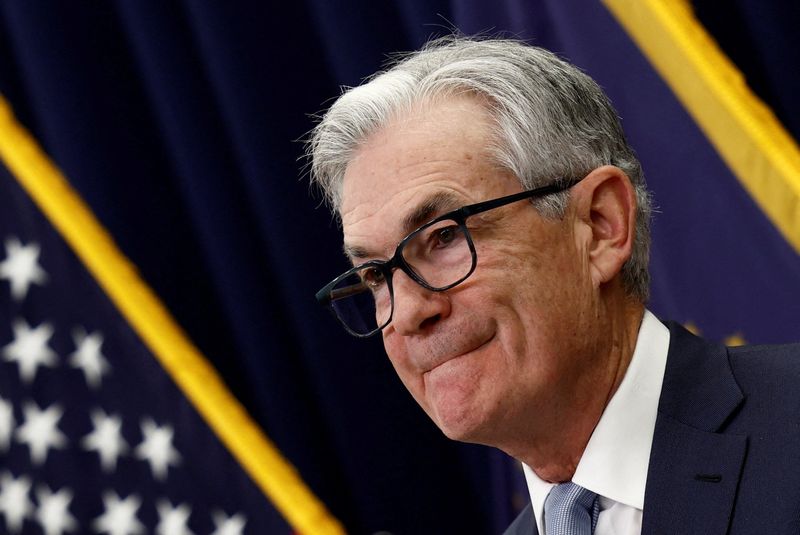By Lindsay (NYSE:LNN) Dunsmuir and Michael S. Derby
(Reuters) - Two months before he became Federal Reserve chair, Jerome Powell urged a gradual approach to raising interest rates so that the U.S. central bank could more adequately assess the true strength of the labor market against tepid inflation, foreshadowing a cautiousness on policy that would persist under his leadership until the coronavirus crisis and its aftermath forced a wholesale change.
Transcripts from the Fed's 2017 policy meetings released Friday showed Powell, then a Fed Board governor, navigating through that year's major policy shifts - the start of balance sheet reduction and a pick-up in the pace of interest rate increases - against a backdrop of sluggish inflation and a job market he and others viewed as approaching full employment.
"I see a need to balance the risk of an overheating economy against that of stubbornly too-low inflation, and I continue to view a gradual approach to removing accommodation as appropriately balancing these two risks," Powell said on Dec. 13, the second day of that year's final policy meeting and 41 days after he had been tapped by President Donald Trump to replace Janet Yellen as Fed chief.
"A gradual pace... will allow us to make a better assessment of the degree of labor market tightness as well as the underlying trend of inflation," Powell said as members of the rate-setting Federal Open Market Committee gave their outlook for 2018 and beyond, according to the transcript.
The transcripts, which are released each January with a five-year delay, also showed debate among Fed policymakers about when to start reducing its $4.5 trillion portfolio of Treasury bonds and mortgage-backed securities, most of which were purchased in the wake of the financial crisis.
Powell faces a similar task this year but with the inflation problem turned on its head. Instead, too-high inflation is the culprit and the Fed, after the fastest pace of interest rate hikes in 40 years, is navigating a tricky task of raising rates high enough to bring inflation down to its 2% target against a very strong labor market, while also allowing time for its campaign of monetary tightening to be fully absorbed by the economy.
As such, the Fed, which has been under Powell's leadership since early 2018, has flagged a downshift this year to a gradual pace of interest rate increases to reduce the risk of a policy mistake.
Back in 2017, the central bank raised interest rates three times as it slowly ramped up borrowing costs amid brisk economic growth and strong job gains that pushed the unemployment rate down to a more than 16-year low, even as inflation struggled to breach the Fed's 2% goal.
Inflation at that point had been below the central bank's target for five years, a softness that prompted Minneapolis Fed President Neel Kashkari to dissent against all three hikes while then Chicago Fed President Charles Evans dissented in December that year.
That was a reverse of 2016, when the Fed only managed to raise interest rates for the second time in a decade, causing two other policymakers to register dissents but for not moving quickly enough.
The Fed's policy rate stood at 1.25% to 1.50% at the end of 2017 following the quarter percentage point moves as the Fed more forcefully began to exit from the emergency actions it took following the 2007-2009 financial crisis and recession.
Part of that withdrawal of stimulus included starting its balance sheet drawdown. In June, Fed officials were worried that later that year markets and the economy could be roiled by political battles over the U.S. government borrowing limits and were concerned about starting the reduction in those potentially unsettled conditions, the transcripts show.
They were also mindful that unlike the current regime of holding press conferences after every policy meeting, such post-meeting briefings only happened quarterly in 2017. For some that made kicking off the balance sheet drawdown at the July meeting less attractive than the September meeting, when then-Chair Yellen would speak with the press at its conclusion.

"I see no advantage at all to moving it to July," then Fed governor Lael Brainard said. "I think this is a big deal… I think this is the kind of thing that you do at a press conference, so that the Chair can explain in great detail and contextualize it."
The Fed ultimately went for a September announcement although a prediction the overall portfolio could shrink to between $2.5 trillion to $3.5 trillion by the early 2020s ran into trouble far sooner, with the central bank only managing to shrink the balance sheet by about 15% before the level of reserves got too low and led to a spike in short-term borrowing costs in September 2019.